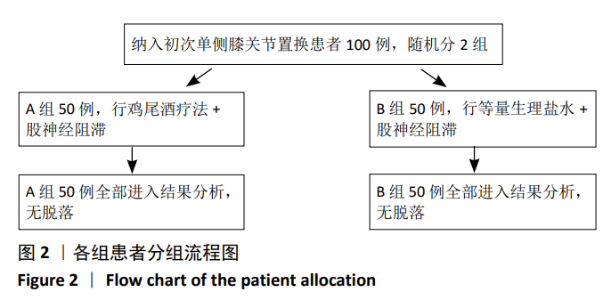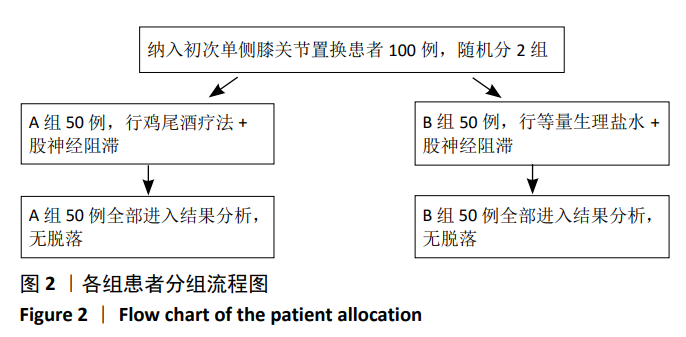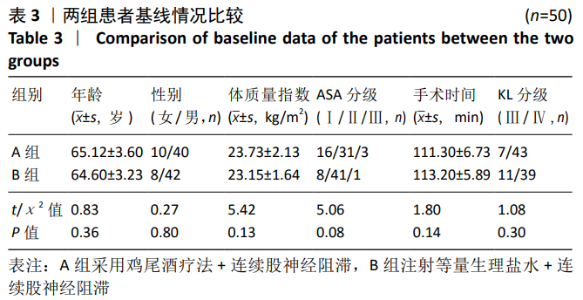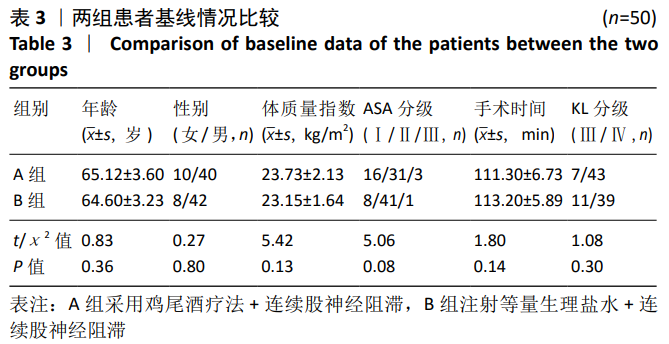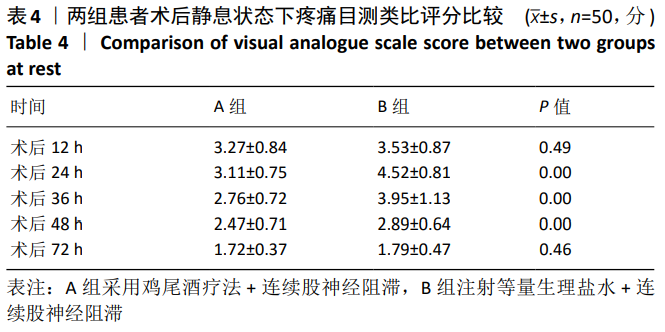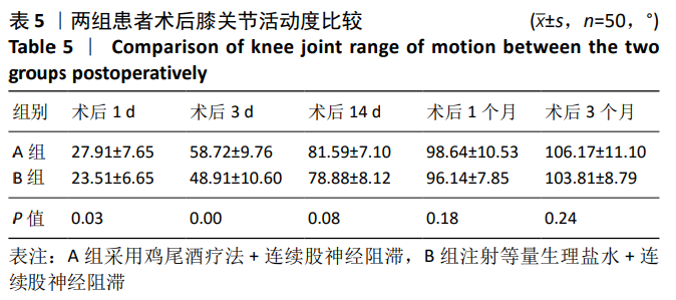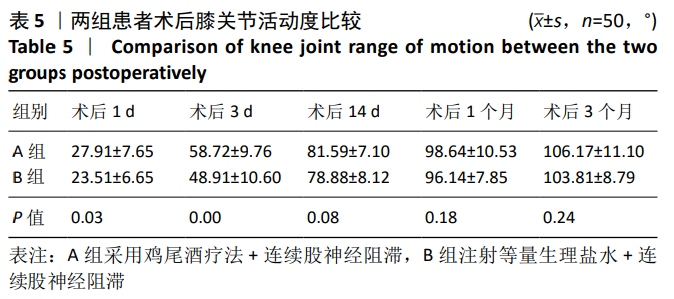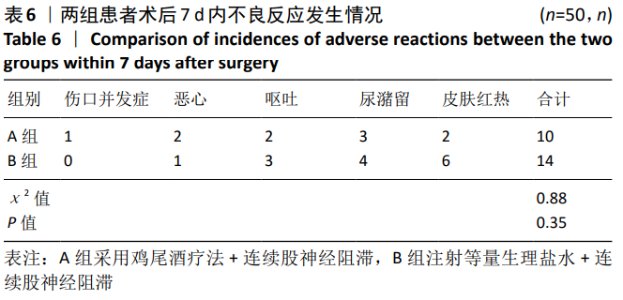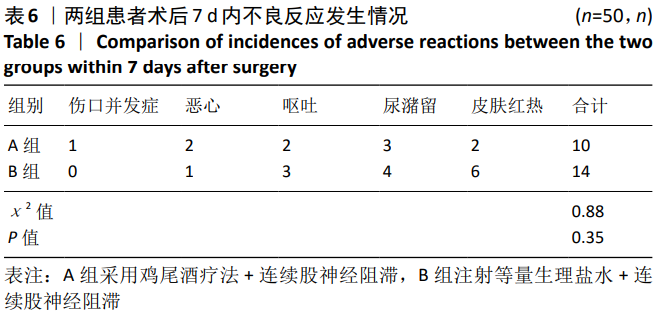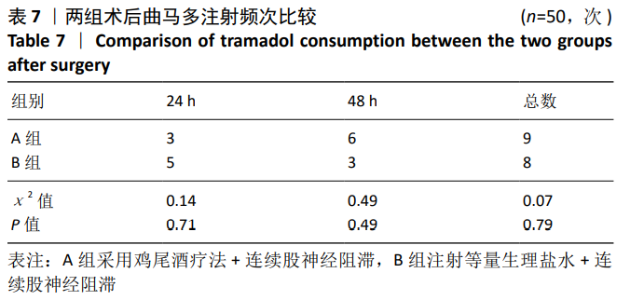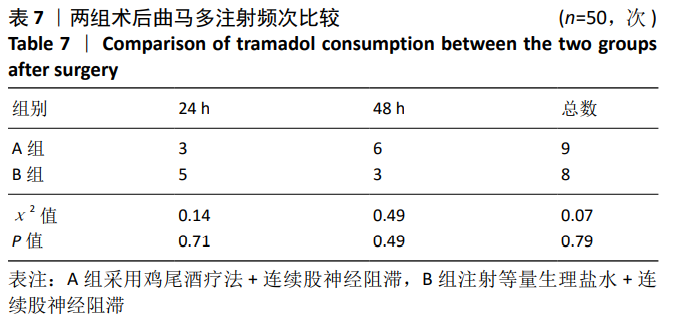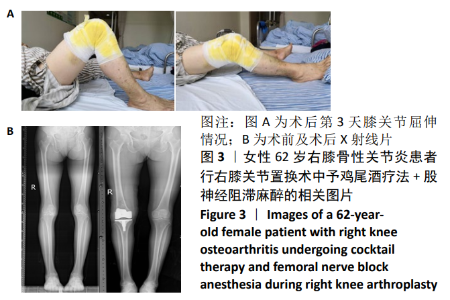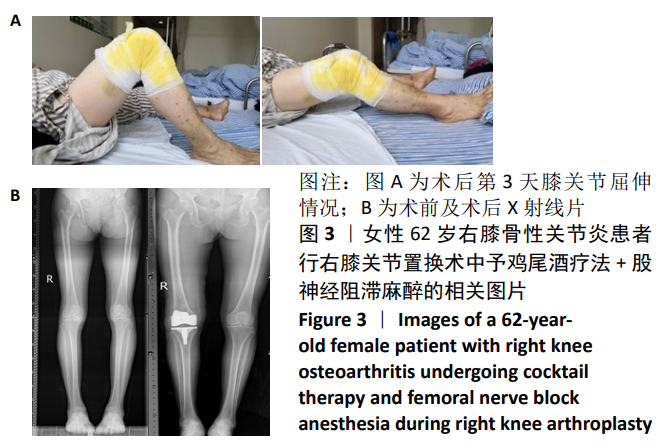Chinese Journal of Tissue Engineering Research ›› 2021, Vol. 25 ›› Issue (6): 866-872.doi: 10.3969/j.issn.2095-4344.2389
Previous Articles Next Articles
Analgesic effect of cocktail therapy combined with femoral nerve block on total knee arthroplasty
Zhang Nianjun1, 2, Chen Ru3
- 1Guangzhou University of Chinese Medicine, Guangzhou 510006, Guangdong Province, China; 2Tenth Department of Orthopedics, Foshan Hospital of Chinese Medicine Affiliated to Guangzhou University of Chinese Medicine, Foshan 528000, Guangdong Province, China; 3Department of Traditional Chinese Medicine, Shunde Hospital, Southern Medical University, Foshan 528300, Guangdong Province, China
-
Received:2020-02-26Revised:2020-03-05Accepted:2020-04-15Online:2021-02-28Published:2020-12-03 -
Contact:Chen Ru, MD, Attending physician, Department of Traditional Chinese Medicine, Shunde Hospital, Southern Medical University, Foshan 528300, Guangdong Province, China -
About author:Zhang Nianjun, Doctoral candidate, Attending TCM physician, Guangzhou University of Chinese Medicine, Guangzhou 510006, Guangdong Province, China; Tenth Department of Orthopedics, Foshan Hospital of Chinese Medicine Affiliated to Guangzhou University of Chinese Medicine, Foshan 528000, Guangdong Province, China -
Supported by:the Medical Research Project of Foshan Health and Family Planning Bureau, No. 20180088
CLC Number:
Cite this article
Zhang Nianjun, Chen Ru. Analgesic effect of cocktail therapy combined with femoral nerve block on total knee arthroplasty[J]. Chinese Journal of Tissue Engineering Research, 2021, 25(6): 866-872.
share this article
Add to citation manager EndNote|Reference Manager|ProCite|BibTeX|RefWorks
| [1] CROSS M, SMITH E, HOY D, et al. The global burden of hip and knee osteoarthritis: estimates from the global burden of disease 2010 study.Ann Rheum Dis. 2014;73(7):13231330. [2] 中华医学会骨科学分会关节外科学组.骨关节炎诊疗指南(2018年版)[J] . 中华骨科杂志,2018,38(12):705-715. [3] KANE RL, SALEH KJ, WILT TJ, et al. The functional outcomes of total knee arthroplasty. J Bone Joint Surg Am. 2005;87(8):1719-1724. [4] YAN CH, CHIU KY, NG FY. Total knee arthroplasty for primary knee osteoarthritis: changing pattern over the past 10 years. Hong Kong Med J. 2011;17(1):20-25. [5] PARADOWSKI PT, KĘSKA R, WITOŃSKI D. Validation of the Polish version of the Knee injury and Osteoarthritis Outcome Score (KOOS) in patients with osteoarthritis undergoing total knee replacemen. BMJ Open. 2015;5(7):e006947. [6] KAHN TL, SOHEILI A, SCHWARZKOPF R. Outcomes of total knee arthroplasty in relation to preoperative patient-reported and radiographic measures: data from the osteoarthritis initiative. Geriatr Orthop Surg Rehabil. 2013;4(4):117-126. [7] CARR AJ, ROBERTSSON O, GRAVES S, et al. Knee replacement. Lancet. 2012;379:1331-1340. [8] NIINIMATKI T, ESKELINEN A, MAKELA K, et al. Unieompartmental knee arthroplasty survivorship is lower than TKA survivorship:a 27-year Finnish registry study. Clin Orthop Relat Res. 2014;472(5):1496-1501. [9] SHUKLA H, NAIR SR, THAKKER D. Role of telerehabilitation in patients following total knee arthroplasty: Evidence from a systematic literature review and meta-analysis. J Telemed Telecare. 2016;23(2):339. [10] VIGAN R, MAREGA L, BREEMANS E,et al.A systematic literature re-view of the Profix in primary total knee arthroplasty. Acta Or-thop Belgica. 2012;78 (1):55-60. [11] UESUGI K, KITANO N, KIKUCHI T, et al. Comparison of peripheral nerve block with periarticular injection analgesia after total knee arthroplasty:A randomized,controlled study. Knee. 2014;21(4):848-852. [12] TANG X, WANG S, ZHAN S, et al. The prevalence of symptomatic knee ostearthitis in China:Results from the China health and retirement longitudinal study. Arthritis Rheumatol. 2016;68(3):648-653. [13] 陈伟,吕红芝,张晓琳,等.中国中老年人群膝关节骨性关节炎患病率流行病学调查设计[J].河北医科大学学报,2015,36(4): 487-489,490. [14] 李容杭,李新宇,何艳萍,等.全膝关节置换术后留置硬膜外镇痛泵与静脉自控镇痛泵镇痛效果比较[J].中华实验外科杂志, 2018, 35(3):577. [15] 王晓东.超声导航连续隐神经阻滞对膝关节置术后康复影响的研究[D].大连:大连医科大学,2017. [16] 孙扬,杨明敏,李亦梅.人工全膝关节置换围术期镇痛方法:多模式方案及最佳疼痛管理[J].中国组织工程研究,2014,18(44): 7188-7193. [17] NOISEUX NO, CALLAGHAN JJ, CLARK CR, et al. Preoperative predictor of pain following total knee arthroplasty. Arthroplasty. 2014; 29(7): 1383-1387. [18] 田渊,王智勇,张志强.全膝关节置换后镇痛:超前和多模式联合镇痛的比较[J].中国组织工程研究,2015,19(44):7108-7133. [19] 陈易,倪新莉.人工膝关节置换术术后镇痛新进展[J].宁夏医科大学学报,2017,39(10):1230-1234. [20] 罗国栋,王文己,韩兴文.全膝关节置换术后镇痛的研究现状[J]. 甘肃医药, 2017,36(11): 921-923. [21] YADEAU JT, BRUMMETT CM, MAYMAN DJ,et al. Duloxetine and subacute pain after knee arthroplasty when added to a multimodal analgesic regimen: A randomized, placebo-controlled,triple-blinded tria. Anesthesiology. 2016; 125(3): 561-572. [22] 沈彬,翁习生,廖刃,等.中国髋、膝关节置换术加速康复——围术期疼痛与睡眠管理专家共识[J]. 中华骨与关节外科杂志, 2016, 9(2):91-97. [23] 张宇.超声引导下连续股神经阻滞在膝关节置换后镇痛中的应用研究[J].中国实用神经疾病杂志,2016,19(16):57-58. [24] 姜俪凡,冯艺,安海燕.人工全膝关节置换术康复锻炼期镇痛方式对关节功能恢复的影响[J].中国疼痛医学杂志,2014,20(2): 90-94. [25] 袁青,崔旭蕾,徐仲煌,等.超声引导下躯干阻滞的临床应用进展[J].临床麻醉学杂志,2017,33(10):1029-1032. [26] 武强,芦海涛,乔海涛.超声引导下外周神经阻滞应用于老年下肢骨科手术的麻醉效果及对术后功能恢复的影响[J].中医药临床杂志,2018,30(9):1715-1717. [27] 郭雅琪,罗娟,岳子勇.超声引导下隐神经阻滞用于全膝关节置换术后镇痛的研究进展[J].实用医学杂志,2018,34(24):4183-4186. [28] 黎阳,刘金凤.超声引导下神经阻滞在全膝关节置换术后镇痛中的研究进展[J].医学综述,2019,25(7):1431-1437. [29] FU P, WU Y, WU H, et al. Efficacy of intra-articular cocktail analgesic injection in total knee arthroplasty-a randomized controlled trial.Knee. 2009;16(4):280-284. [30] 程开源.局部浸润注射和连续股神经阻滞在全膝关节置换术后病人镇痛效果的比较:系统综述和荟萃分析[D].济南:山东大学,2017. [31] 李佳东.鸡尾酒疗法对全膝关节置换术后疼痛控制及功能恢复的疗效评价[D].大连:大连医科大学,2019. [32] CHUGHTAI M,JAUREGUI JJ,MISTRY JB,et al,What Influences How Patients Rate Their Hospital after Knee Arthroplasty? Surg Technol Int. 2016;28:261-265. [33] J KELLGREN JH, LAWRENCE JS. RadMogical assessment of osteoarthrosis. Annrheum Dis. 1957;16(41):494-502. [34] 中华医学会骨科学分会关节外科学组.骨关节炎诊疗指南 (2018年版) [J].中华骨科杂志, 2018, 38(12) :705-715. [35] 王波,余楠生.膝骨关节炎阶梯治疗专家共识(2018年版)[J].中华关节外科杂志(电子版),2019,13(1):124-130. [36] 曹彭凯,王晓猛,白伟侠,等.2018年版《骨关节炎诊疗指南》解读[J].河北医科大学学报,2018,39(11):1241-1243. [37] 徐建达.选择性COX-2抑制剂塞来昔布在全膝关节置换超前镇痛中的应用及炎性机制研究[D].广州:南方医科大学,2018. [38] 周玲,孔红武,王薇.慢性疼痛患者整体疼痛评估量表的汉化及信效度评价[J].中华护理杂志,2014,49(9):1121-1124. [39] 陈佳佳,童莺歌,柴玲,等.中文版多维疼痛评估工具的比较分析[J].护理学杂志,2018,33(6):102-105. [40] 薄纯露,章笑天,翟静,等.成人疼痛评估多维度量表的研究进展[J].护理管理杂志,2018,18(3):218-221+225. [41] WASSERSTEIN D, FARLINGER C, BRULL R, et al. Advanced age,obesity and continuous femoral nerve blockade are independent risk factors for inpatient falls after primary total knee arthroplasty. J Arthroplasty. 2013;28(7) :1121-1124. [42] PELT CE, ANDERSON AW, ANDERSON MB, et al. Postoperative falls after total knee arthroplasty in patients with a femoral nerve catheter: Can we reduce the incidence? J Arthroplasty. 2014;29(6):1154-1157. [43] 朱先洋. 多模式镇痛背景下神经阻滞与鸡尾酒疗法在全膝置换中的作用比较[D].合肥:安徽医科大学,2017. [44] TAHA AM, ABD-ELMAKSOUD AM. Arthroscopic medial meniscus trimming or repair under nerve blocks: Which nerves should be blocked? Saudi J Anaesth. 2016;10(3):283-287. [45] TSUKADA S, WAKUI M, HOSHINO A. The impact of including corticosteroid in a periarticular injection for pain control after total knee arthroplasty: a double-blind randomised controlled trial. Bone Joint J. 2016;98-B(2):194-200. [46] FRASSANITO L, VERGARI A, NESTORINI R, et al. Enhanced recovery after surgery (ERAS) in hip and knee replacement surgery: description of a multidisciplinary program to improve management of the patients undergoing major orthopedic surgery. Musculoskeletal Surg. 2020;104(1):87-92. [47] BIANCONI M, FERRARO L, TRAINA GC, et al. Pharmacokinetics and efficacy of ropivacaine continuous wound instillation after joint replacement surgery. Br J Anaesth. 2003;91(6):830-835. [48] 冯殿鹏,刘广慧,姜涛.鸡尾酒在膝关节置换术后的应用效果[J]. 中国当代医药,2017,24(29):103-105. [49] 李佳东.鸡尾酒疗法对全膝关节置换术后疼痛控制及功能恢复的疗效评价[D].大连:大连医科大学,2019. [50] 邹艳杰,曹忠平.膝关节置换术中应用鸡尾酒疗法罗哌卡因中毒一例[J].临床麻醉学杂志,2017,33(8):832. [51] SARZAEEM MM, RAZI M, KAZEMIAN G, et al. Comparing effiacy of three methods of tranexamic acid administration in reducing hemoglobin drop following total knee arthroplasty. J Arthroplasty. 2014;29(8):1521-1524. [52] 崔丹荔,雷一霆,许宏,等.人工全髋关节置换术中首次大剂量联合术后五次静脉应用氨甲环酸的前瞻性临床研究[J].中国修复重建外科杂志, 2019, 33(8):935-939. [53] 黄勇,刘俊宾,房好林.初次髋关节置换患者氨甲环酸不同给药途径比较的前瞻性研究[J].中国骨与关节杂志, 2018, 7(12):885-890. [54] IKEUCHI M, KAMIMOTO Y, IZUMI M, et al. Effects of dexamethasone on local infitration analgesia in total knee arthroplasty:a randomized controlled trial. Knee Surg Sports Traumatol Arthrosc. 2014; 22(7): 1638-1643. [55] YUE DB, WANG BL, LIU KP, et al. Efficacy of multimodal cocktail periarticular injection with or without steroid in total knee arthroplasty. Chin Med J (Engl). 2013;126(20):3851-3855. [56] 李婷,李开鹏.地佐辛与芬太尼对下肢骨折内固定取出术神经阻滞效果比较[J].中国药业,2018,27(1):44-46. [57] GAUTAM VK, KUMAR A, AGARWAL M, et al. Comparative evaluation of periarticular infiltration of two cocktail regimens for analgesia in post-operative patients of total knee replacement. J Arthrosc Joint Surg. 2019;6(2):98-102. |
| [1] | Jiang Yong, Luo Yi, Ding Yongli, Zhou Yong, Min Li, Tang Fan, Zhang Wenli, Duan Hong, Tu Chongqi. Von Mises stress on the influence of pelvic stability by precise sacral resection and clinical validation [J]. Chinese Journal of Tissue Engineering Research, 2021, 25(9): 1318-1323. |
| [2] | Zhang Yu, Tian Shaoqi, Zeng Guobo, Hu Chuan. Risk factors for myocardial infarction following primary total joint arthroplasty [J]. Chinese Journal of Tissue Engineering Research, 2021, 25(9): 1340-1345. |
| [3] | Li Dadi, Zhu Liang, Zheng Li, Zhao Fengchao. Correlation of total knee arthroplasty efficacy with satisfaction and personality characteristics [J]. Chinese Journal of Tissue Engineering Research, 2021, 25(9): 1346-1350. |
| [4] | Wei Wei, Li Jian, Huang Linhai, Lan Mindong, Lu Xianwei, Huang Shaodong. Factors affecting fall fear in the first movement of elderly patients after total knee or hip arthroplasty [J]. Chinese Journal of Tissue Engineering Research, 2021, 25(9): 1351-1355. |
| [5] | Wang Jinjun, Deng Zengfa, Liu Kang, He Zhiyong, Yu Xinping, Liang Jianji, Li Chen, Guo Zhouyang. Hemostatic effect and safety of intravenous drip of tranexamic acid combined with topical application of cocktail containing tranexamic acid in total knee arthroplasty [J]. Chinese Journal of Tissue Engineering Research, 2021, 25(9): 1356-1361. |
| [6] | Xiao Guoqing, Liu Xuanze, Yan Yuhao, Zhong Xihong. Influencing factors of knee flexion limitation after total knee arthroplasty with posterior stabilized prostheses [J]. Chinese Journal of Tissue Engineering Research, 2021, 25(9): 1362-1367. |
| [7] | Peng Zhihao, Feng Zongquan, Zou Yonggen, Niu Guoqing, Wu Feng. Relationship of lower limb force line and the progression of lateral compartment arthritis after unicompartmental knee arthroplasty with mobile bearing [J]. Chinese Journal of Tissue Engineering Research, 2021, 25(9): 1368-1374. |
| [8] | Huang Zexiao, Yang Mei, Lin Shiwei, He Heyu. Correlation between the level of serum n-3 polyunsaturated fatty acids and quadriceps weakness in the early stage after total knee arthroplasty [J]. Chinese Journal of Tissue Engineering Research, 2021, 25(9): 1375-1380. |
| [9] | Lü Zhen, Bai Jinzhu. A prospective study on the application of staged lumbar motion chain rehabilitation based on McKenzie’s technique after lumbar percutaneous transforaminal endoscopic discectomy [J]. Chinese Journal of Tissue Engineering Research, 2021, 25(9): 1398-1403. |
| [10] | Zhang Shangpu, Ju Xiaodong, Song Hengyi, Dong Zhi, Wang Chen, Sun Guodong. Arthroscopic suture bridge technique with suture anchor in the treatment of acromioclavicular dislocation [J]. Chinese Journal of Tissue Engineering Research, 2021, 25(9): 1417-1422. |
| [11] | Yuan Jiawei, Zhang Haitao, Jie Ke, Cao Houran, Zeng Yirong. Underlying targets and mechanism of Taohong Siwu Decoction in prosthetic joint infection on network pharmacology [J]. Chinese Journal of Tissue Engineering Research, 2021, 25(9): 1428-1433. |
| [12] | Chen Junming, Yue Chen, He Peilin, Zhang Juntao, Sun Moyuan, Liu Youwen. Hip arthroplasty versus proximal femoral nail antirotation for intertrochanteric fractures in older adults: a meta-analysis [J]. Chinese Journal of Tissue Engineering Research, 2021, 25(9): 1452-1457. |
| [13] | Huang Dengcheng, Wang Zhike, Cao Xuewei. Comparison of the short-term efficacy of extracorporeal shock wave therapy for middle-aged and elderly knee osteoarthritis: a meta-analysis [J]. Chinese Journal of Tissue Engineering Research, 2021, 25(9): 1471-1476. |
| [14] | Liu Yafei, Wang Yalin, Zuo Yanping, Sun Qi, Wei Jing, Zhao Lixia. Structural changes of the temporomandibular joint in adolescents with skeletal Class III malocclusions after maxillary protraction: an X-ray measurement analysis [J]. Chinese Journal of Tissue Engineering Research, 2021, 25(8): 1154-1159. |
| [15] | Gao Yan, Zhao Licong, Zhao Hongzeng, Zhu Yuanyuan, Li Jie, Sang Deen. Alteration of low frequency fluctuation amplitude at brain-resting state in patients with chronic discogenic low back pain [J]. Chinese Journal of Tissue Engineering Research, 2021, 25(8): 1160-1165. |
| Viewed | ||||||
|
Full text |
|
|||||
|
Abstract |
|
|||||
